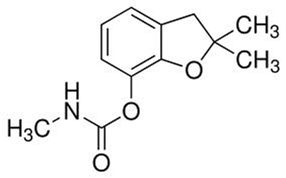Carbofuran and Wildlife Poisoning: Global Perspectives and Forensic Approaches
Book review by Roger Reeve
ECG Committee Member
University of Sunderland
ECG Bulletin January 2012
ECG Committee Member
University of Sunderland
ECG Bulletin January 2012
Carbofuran and Wildlife Poisoning: Global Perspectives and Forensic Approaches describes the legal and illegal uses of the pesticide Carbofuran and its environmental effects in a number of countries throughout the world. Each chapter has scientific depth with the overall style almost as a narrative of the discovery of the problems arising from the use of Carbofuran. The book is multidisciplinary throughout, indeed emphasising that such an approach is necessary to control the risks posed by this product. Each chapter is written by locally-based experts in the field and is well cross-referenced. Simple introductions to each of the chapters are helpful when delving into less familiar topics and make the text very readable. The book as a whole is well referenced to January 2011.
Carbofuran is a systemic carbamate insecticide and is also used as an acaricide and a nematocide.
The acute toxicity of Carbofuran has been evaluated in several species. The reported oral LD50s are 6.4 to 14.1 mg/kg for rats, 18.5 mg/kg for dogs, and 25 to 38.9 mg/kg for chickens. Mice appear to be less sensitive to the toxicity of Carbofuran as the median lethal doses ranged from 250 to 500 mg/kg. The lethal effects of Carbofuran are due largely to the chemical’s direct inhibition of acetylcholinesterase. Ultimate cause of death is respiratory failure. Signs and symptoms of cholinesterase poisoning occur within minutes as Carbofuran acts directly on the enzyme without metabolic activation. Variations in species sensitivity probably reflect species differences in metabolic deactivation of Carbofuran to its less potent metabolic products. The compound is sparingly soluble in water (700 mg/L) and has the potential to contaminate aquatic resources. Exposure of wildlife can be through direct ingestion or via contaminated water¸ soil and sediments. Illegal baiting should also be included. Degradation is very environment specific but it tends to be more stable in acidic soils. Photochemical degradation, occurring particularly in tropical and sub-tropical regions, can produce products which are more toxic than the original compound.
Carbofuran is a systemic carbamate insecticide and is also used as an acaricide and a nematocide.
The acute toxicity of Carbofuran has been evaluated in several species. The reported oral LD50s are 6.4 to 14.1 mg/kg for rats, 18.5 mg/kg for dogs, and 25 to 38.9 mg/kg for chickens. Mice appear to be less sensitive to the toxicity of Carbofuran as the median lethal doses ranged from 250 to 500 mg/kg. The lethal effects of Carbofuran are due largely to the chemical’s direct inhibition of acetylcholinesterase. Ultimate cause of death is respiratory failure. Signs and symptoms of cholinesterase poisoning occur within minutes as Carbofuran acts directly on the enzyme without metabolic activation. Variations in species sensitivity probably reflect species differences in metabolic deactivation of Carbofuran to its less potent metabolic products. The compound is sparingly soluble in water (700 mg/L) and has the potential to contaminate aquatic resources. Exposure of wildlife can be through direct ingestion or via contaminated water¸ soil and sediments. Illegal baiting should also be included. Degradation is very environment specific but it tends to be more stable in acidic soils. Photochemical degradation, occurring particularly in tropical and sub-tropical regions, can produce products which are more toxic than the original compound.
|
The broad effect range of Carbofuran has led to its worldwide use including control on sugar cane, sugar beet, maize, coffee and rice crops. It is sold in a number of formulations including liquid, silica-based and granular forms. Carbofuran has been commercially available since 1967 and although it can be seen as old-fashioned compared with later pesticides, which discriminate between target and non-target organisms, it still has a market in territories where it is not prohibited. Introductory chapters give an overview of the problem and the impact on birds. Birds are particularly susceptible to poisoning though the scientific reason behind this is unclear. The median LD50 for a range of birds is 1.65 mg/kg.
|
The editor’s original research was on the decline in population of vultures in Kenya, and she quickly discovered the major contribution of Carbofuran in this decline. In other parts of the world Carbofuran may also be a significant contributing factor to the loss of wildlife. The choice of the formulation may be part of the problem, birds often seeing granular formulations as seed. It is almost totally lacking in odour and taste. The chapters describe the different ways wildlife can be exposed, signs that can be used to recognise intoxication, diagnosis of Carbofuran kills and how poisoned birds can be rehabilitated.
Restrictions or cancelled registration for the use of Carbofuran products are now in place in all the developed territories studied (EU, US, Canada), but Carbofuran-related wildlife mortality continues. So little pesticide is needed for illegal bird-kills that the problem may well continue for many years even with remaining stocks of the pesticide, and one cited reference, referring to Scotland, showed that Carbofuran was the most used pesticide for illegal activities.
Carbofuran and Wildlife Poisoning: Global Perspectives and Forensic Approaches is useful for anyone who wishes to gain insight into the complexities of current global environmental problems and control as well as those interested in the narrower area of Carbofuran use and abuse.
Carbofuran and Wildlife Poisoning: Global Perspectives and Forensic Approaches is useful for anyone who wishes to gain insight into the complexities of current global environmental problems and control as well as those interested in the narrower area of Carbofuran use and abuse.
Carbofuran and Wildlife Poisoning: Global Perspectives and Forensic Approaches
Ngaio Richards (Editor)
Wiley Blackwell, Chichester, UK,
November 2011, pp xxvi + 277
ISBN 978-0-470-74523-6
£90.00 (hardcover)
Ngaio Richards (Editor)
Wiley Blackwell, Chichester, UK,
November 2011, pp xxvi + 277
ISBN 978-0-470-74523-6
£90.00 (hardcover)



